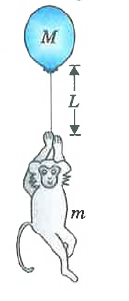A monkey of mass m moves up on a massless string so as to just lift a block of mass M. After some time the monkey stops moving w.r.t the string. Find the magnitude of the change in the monkey's acceleration.
When the monkey moves up with acceleration .a. to lift the block
m(g+a)=Mg
a=(M−m)gm
when monkey stops
a1=(M−m)gM+m∴Δa=a−a1=Mg(M−m)m(M+m)

Similar Questions
A monkey of mass m moving up on a massless string so as to just lift a block of mass M. After some time the monkey stops moving w.r.t the string. Find the magnitude of the change in the monkey's acceleration.
View SolutionThe pulley shown in the diagram is frictionless. A cat of mass 1kg moves up on the massless string so as to just lift a block of mass 2kg. After some time, the cal stops moving with respect to the string. The magnitude of the change in the cat's accelration is

View Solution
Knowledge Check
The pulley shown in the diagram is frictionless. A cat of mass 1kg moves up on the massless string so as to just lift a block of mass 2kg. After some time, the cal stops moving with respect to the string. The magnitude of the change in the cat's accelration is
 AgBg3C2g3D4g3
AgBg3C2g3D4g3A monkey of mass 40 kg climbs on a massless rope of breaking strength 600 N. The rope will break if the monkey. (Take g=10m/s2)
Aclimbs up with a uniform speed of 6m/sBclimbs up with an acceleration of 6m/s2Cclimbs down with an acceleration of 4m/s2Dclimbs down with a uniform speed of 5m/sA monkey of mass 40kg climbs on a massless rope of breaking strenght 600N. The rope will break if the monkey (Take g=10m/s2) .
Aclimbs up with a uniform speed of 6m/sBclimbs up with an acceleration of 6m/s2Cclimbs with an acceleration of 4m/s2Dclimbs down with a uniform speed of of 5m/s2
A 10 kg monkey climbs up a massless rope that runs over a frictionless tree limb and back down to a 15 kg package on the ground (Fig. 5-56). (a) What is the magnitude of the least acceleration the monkey must have if it is to lift the package off the ground? If, after the package has been lifted, the monkey stops its climb and holds on to the rope, what are the (b) magnitude and (c) direction of the monkey's acceleratiohn and (d) the tension in the rope ?

View SolutionA monkey of mass m climbs up to a rope hung over a fixed pulley. The opposite end of the rope is tied to a weight of mass M lying on a horizontal plane. Neglecting the friction, find the acceleration of both the bodies (relative to the plane) and the tension of the rope for the three cases:
(i) The monkey does not move with respect to the rope
(ii) The monkey moves upwards with respect to the rope with acceleration a.
(iii) The monkey moves downwards with respect to the rope, with acceleration a.
View SolutionA block of mass m is attached with a massless in string. Breaking strength of string is 4mg. Block is moving up. The maximum acceleration and maximum retardation of the block can be

View SolutionMonkey of mass m is holding the end of string connected to a balloon of mans M. Length of the string is L and the complete system remains at rest in mid air as shown in figure. Monkey starts to climb to catch the balloon. Calculate distance travelled by balloon by the time monkey reaches the balloon.

View SolutionA block of mass m is attached with a massless in string. Breaking strength of string is 4mg. Block is moving up. The maximum acceleration and maximum retardation of the block can be

View Solution
